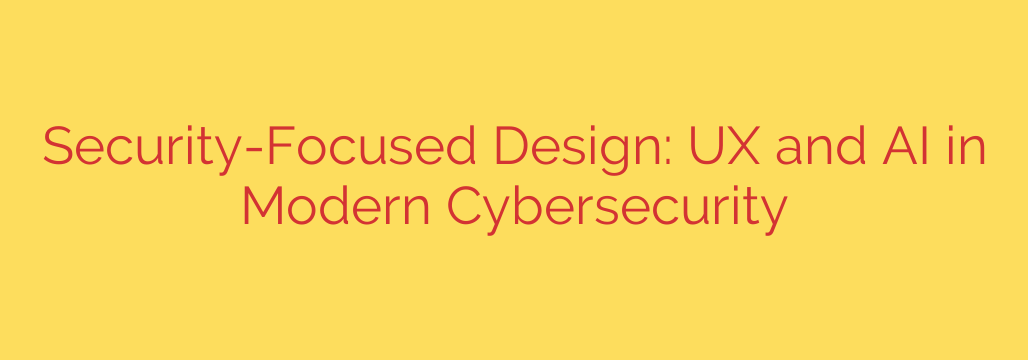
The Future of Defense: How AI and User-Focused Design are Revolutionizing Cybersecurity
In the relentless battle against cyber threats, organizations have traditionally focused on building higher, more complex digital walls. Yet, a crucial element has often been overlooked: the human user. Complicated security protocols and unintuitive tools can lead to frustration, workarounds, and ultimately, human error. Today, a powerful new paradigm is emerging: security-focused design, a discipline that places the user at the center of our defense strategies, supercharged by the intelligence of Artificial Intelligence (AI).
This shift isn’t just about aesthetics; it’s a fundamental change in how we approach digital safety. By making security intuitive and intelligent, we can empower users to become our strongest asset rather than our weakest link.
The Human Factor: Why Traditional Security Often Fails
For years, the prevailing belief was that stronger security required more friction. More passwords, more verification steps, and more alerts. However, this approach has led to a widespread problem known as “security fatigue.” When users are constantly bombarded with complex and disruptive security measures, they begin to ignore them, choose weak passwords for convenience, or bypass protocols altogether.
The reality is stark: human error remains one of the leading causes of security breaches. A perfectly engineered security system is useless if a user finds it too difficult to use correctly. This is where security-focused design changes the game.
What is Security-Focused Design?
Security-focused design, also known as “usable security,” is an approach that integrates security seamlessly and intuitively into the user experience (UX). The goal is to make secure practices the easiest and most natural path for the user to take.
Key principles of this approach include:
- Intuitive Interfaces: Designing security tools that are clean, simple, and easy to understand. Users shouldn’t need a manual to know how to protect themselves.
- Frictionless Security: Whenever possible, security should operate in the background. For example, systems that automatically encrypt data or flag suspicious emails without requiring constant user input.
- Clear Communication: Replacing technical jargon with plain language. Instead of a cryptic error code, a system should explain what the threat is and what the user needs to do in simple terms.
- Empowering Users: Providing users with clear choices and control over their security without overwhelming them. This builds trust and encourages proactive engagement.
By focusing on the user, we reduce the cognitive load required to stay safe, making secure behavior the default.
The AI Advantage: Making Security Smarter and Simpler
This is where Artificial Intelligence enters the picture as a powerful ally. AI and machine learning are uniquely capable of handling the scale and complexity of modern cyber threats, all while simplifying the experience for the end-user.
1. Automating Threat Detection and Response
AI algorithms can analyze vast amounts of data in real-time to identify patterns and anomalies that a human analyst would miss. AI-powered systems can detect and neutralize threats like malware, phishing attempts, and unusual network activity before they ever reach the user, reducing the number of alerts and decisions a person has to make.
2. Simplifying Complex Information
Security dashboards are often flooded with data that is meaningless to the average user. AI can process this information and present it through simple, visual dashboards. It can translate millions of data points into a single, actionable insight, such as, “A login attempt from an unusual location was blocked.”
3. Personalizing Security Guidance
Instead of generic, one-size-fits-all warnings, AI can provide personalized, context-aware security advice. For example, if a user is about to download a potentially risky file, an AI-driven system can provide an “intelligent nudge,” explaining the specific risk in a clear, non-alarming way and suggesting a safer alternative.
Actionable Steps for a More Secure, Usable Future
Integrating user-centric design and AI is essential for any organization serious about modern cybersecurity. Here are some practical steps to get started:
- Prioritize the User from Day One: Involve users in the design process for any new security tool or policy. Conduct user testing to identify points of friction and confusion before a system is deployed.
- Make Security Invisible but Transparent: Strive to have security measures run in the background. However, when a security action is taken, ensure the system provides clear, transparent feedback to the user about what happened and why.
- Leverage AI for Intelligent Automation: Invest in modern security solutions that use AI to automate routine tasks and threat detection. This frees up your security team to focus on high-level strategy and reduces the burden on your employees.
- Create Clear Feedback Loops: Encourage users to report suspicious activity and make the reporting process as simple as possible. Use this feedback not only to address immediate threats but also to train your AI models to become more accurate over time.
The future of cybersecurity isn’t just about building higher walls; it’s about building smarter, more intuitive systems. By merging the empathy of user-centric design with the analytical power of artificial intelligence, we can create a digital world that is not only significantly safer but also easier and less stressful for everyone to navigate.
Source: https://www.paloaltonetworks.com/blog/2025/07/security-by-design-ux-ai-modern-cybersecurity/








